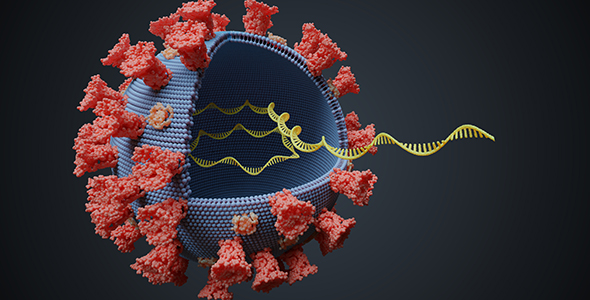By the bioMérieux Connection Editors
Interviewing: Alex van Belkum, PhD, F(AAM), Microbiologist at bioMérieux
By now, many people have heard about the need for a national sequencing strategy to aid in the fight against COVID-19. While those efforts are focused on tracking the virus and identifying new strains, there are many areas where gene sequencing is important for battling this pandemic and infectious diseases more generally. We sat down with Dr. Alex van Belkum, the microbiologist at bioMérieux, to answer some questions about gene sequencing and why it’s important.
What is Sequencing and What Can it Tell Us About Infectious Diseases?
Nucleic Acid Sequencing, sometimes colloquially called Gene Sequencing, is the technology that scientists use to identify the order (sequence) of the building blocks that make up genetic material. Its results can help identify genes, the areas between genes called intergenic regions, variation between pathogen strains, and other aspects of a pathogen’s genetic makeup. Detection of variation is how scientists can identify the new variants of the SARS-CoV-2 virus as they arise.
In addition to information about whether pathogens are related to one another, “In clinical microbiology, sequencing provides information on whether an organism is present in a certain environment (e.g. a patient with an apparent infection),” says Dr. van Belkum. “It can identify to which species this organism belongs and it can help establish whether the organism is resistant to antibiotics, whether it can form biofilms, whether it can metabolize (“eat”) certain compounds in the environment, whether it produces toxins, or other virulence factors.” This type of information can sometimes be helpful to clinicians in cases where they require more detailed information about an infectious agent causing a given infection, but it is more often useful in the context of diagnostic research & development or infection surveillance.
What are the Limitations of Sequencing?
Before exploring all of the benefits of nucleic acid sequencing, it’s important to understand that, like any technology, it has some limitations. While sequencing is a very powerful tool, it can be expensive and often takes time to execute, though methods have been getting cheaper and faster in recent years. DNA must be purified before it can be sequenced, which is not always easy and can result in a low yield of genetic material or poor-quality material. Sometimes, a pathogen’s DNA is difficult to sequence or clone because sections are structurally less stable and prone to degradation. Additionally, it can be difficult to detect a pathogen from a complex sample because there is so much “noise” from the host’s genome and the genomes of other usually non-pathogenic microbes. It’s also important to utilize the right enzymes in the process, because a lack of precision can lead to mistakes.
How Have Sequencing Data Been Used During the Pandemic?
Genomic data has been critical in areas such as diagnostic development, vaccine development, and epidemiologic surveillance for COVID-19. Dr. van Belkum shares that, “The development of diagnostic tests requires knowledge of the sequence of the virus. The commonly-used PCR tests need to be targeted specifically to the RNA of the SARS-CoV-2 virus (and nothing else) and for that, precise sequence information is required.” He continues, “The same holds true for immunological tests where peptides are used. These can be deduced from sequencing information. Continuous sequencing of virus isolates during the outbreak helps identify changes in the viral sequence and defines whether or not the diagnostic tools need to be adapted to this variation.”
On the subject of vaccine development, Dr. van Belkum says that, “Vaccines usually target domains that are not too variable. In that case, all virus strains can be tackled using a single vaccine type. So, sequencing can be used to identify those regions in the virus that are likely to be exposed to the immune system and which are also demonstrated to not vary too much.” The COVID-19 vaccines provide an example of this strategy—the mRNA vaccines that are currently available leverage the genes that are responsible for the virus’s spike protein, which was identified to be in an area that was well accessible to antibodies and less likely to mutate because of its essential role in allowing the SARS-CoV-2 virus to infect our cells.
Finally, surveillance has been critically important throughout the pandemic, allowing researchers to track the development and spread of SARS-CoV-2 variants. “Tracking and tracing of variants is important,” Dr. van Belkum says, “especially if the variants behave differently from the archetypes. Sequencing is pivotal in that domain. Comparing sequences will allow for 1) variant identification 2) tracing variants, and 3) predicting possible diseases invoking potential of a variant.” There are multiple efforts around the world that are sequencing and tracking the SARS-CoV-2 virus, such as COG-UK and GISAID.
Those efforts illustrate the public health value of nucleic acid sequencing. As Dr. van Belkum puts it, “Sequencing defines the presence and nature of pathogens. Sequencing of material obtained from volunteers and patients during surveillance defines where a pathogen is located, where it may be spreading to, whether it evolves and adapts to change the speed with which it spreads, the severity of the diseases it causes, whether it remains susceptible to the available vaccines, and more.”

About Alex van Belkum, PhD, F(AAM): Dr. van Belkum is a molecular microbiologist from The Netherlands, who joined the team at bioMérieux 10 years ago after a 20-year academic career with the Erasmus Medical Center in Rotterdam. His current research interests cover several different technical areas of clinical diagnostic microbiology, including susceptibility testing and applications of Next Generation Sequencing. More broadly, his interests and expertise have encompassed epidemiology of infectious diseases, antimicrobial resistance and susceptibility, as well as pathogen characterization. Dr. van Belkum is also a proud father of three daughters and grandfather to five grandchildren.
Opinions expressed in this article are not necessarily those of bioMérieux, Inc.



